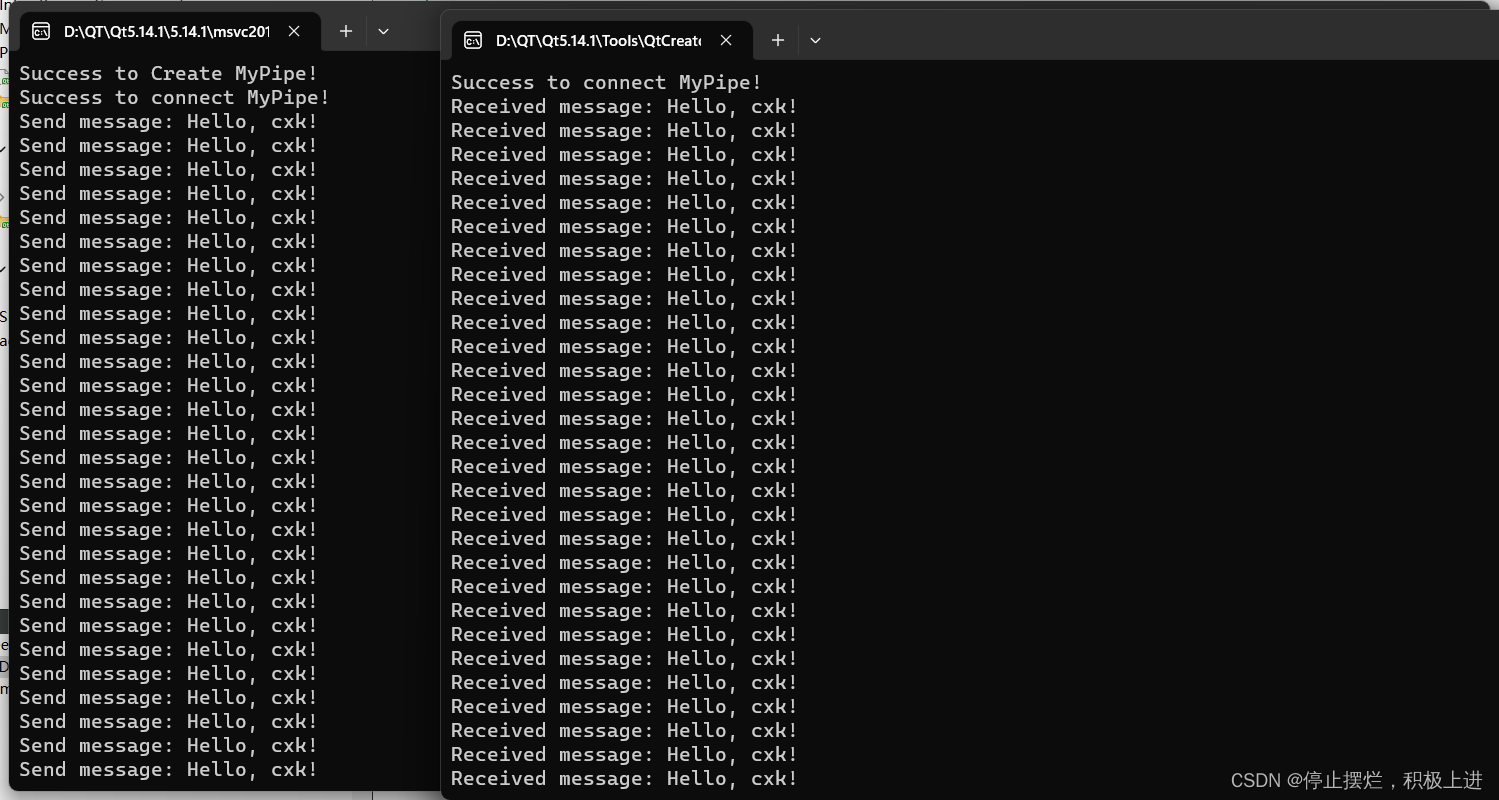文章目录
前情回顾
上一期已经讲解过了进程的相关概念以及进程间通信的实现原理,下面仅展示管道通信机制实现进程间通信的相关代码。
思路
/*
本项目主要用于以管道通信的方式进行进程间通信的测试。
1.主要包含PublisherDemo和SubscriberDemo两个子项目,分别用于发送信息和接收信息。
2.在PublisherDemo中,程序创建一个命名管道,并连接到该管道。然后,使用WriteFile函数向管道写入消息。
3.在SubscriberDemo中,程序连接到同一个命名管道,并使用ReadFile函数从管道读取消息,并打印收到的消息。
*/
源码
环境:Windows 64位 + QtCreator
涉及到一些WINAPI中的函数,具体函数解析可自行参考WINAPI官方文档
Publisher.cpp
#include <iostream>
#include <Windows.h>
#include <WinUser.h>
#pragma comment "win32.lib"
int main() {
HANDLE hPipe;
char buffer[1024];
DWORD bytesRead;
// 创建管道
hPipe = CreateNamedPipe(
L"\\\\.\\pipe\\MyPipe", // 管道名称
PIPE_ACCESS_OUTBOUND, // 只用于写入
PIPE_TYPE_BYTE | PIPE_WAIT,// 字节类型,阻塞模式
1, // 最多可以有一个实例
0, // 输出缓冲区大小
0, // 输入缓冲区大小
0, // 默认超时时间
NULL // 默认安全性
);
if (hPipe == INVALID_HANDLE_VALUE) {
std::cout << "Error: Failed to create pipe!" << std::endl;
return 1;
}
std::cout << "Success to Create MyPipe!" << std::endl;
// 连接到管道
if (!ConnectNamedPipe(hPipe, NULL)) {
std::cout << "Error: Failed to connect to pipe!" << std::endl;
CloseHandle(hPipe);
return 1;
}
std::cout << "Success to connect MyPipe!" << std::endl;
// 发送消息
strcpy_s(buffer, "Hello, cxk!");
while(1)
{
if (!WriteFile(hPipe, buffer, strlen(buffer) + 1, &bytesRead, NULL)) {
std::cout << "Error: Failed to write to pipe!" << std::endl;
CloseHandle(hPipe);
return 1;
}
std::cout << "Send message: Hello, cxk!" << std::endl;
Sleep(1000);
}
// 关闭管道
CloseHandle(hPipe);
getchar();
return 0;
}
Subscriber.cpp
#include <iostream>
#include <Windows.h>
int main() {
HANDLE hPipe;
char buffer[1024];
DWORD bytesRead;
// 连接到管道
hPipe = CreateFile(
L"\\\\.\\pipe\\MyPipe", // 管道名称
GENERIC_READ, // 只用于读取
0, // 共享模式,默认为独占
NULL, // 默认安全性
OPEN_EXISTING, // 打开现有的管道
0, // 默认属性
NULL // 默认模板
);
if (hPipe == INVALID_HANDLE_VALUE) {
std::cout << "Error: Failed to connect to pipe!" << std::endl;
return 1;
}
std::cout << "Success to connect MyPipe!" << std::endl;
while(1)
{
// 读取消息
if (!ReadFile(hPipe, buffer, sizeof(buffer), &bytesRead, NULL)) {
std::cout << "Error: Failed to read from pipe!" << std::endl;
CloseHandle(hPipe);
return 1;
}
std::cout << "Received message: " << buffer << std::endl;
Sleep(1000);
}
// 关闭管道
CloseHandle(hPipe);
return 0;
}
注:以上程序运行顺序应该为:先启动Publisher.exe,再启动Subscriber.exe。
效果
